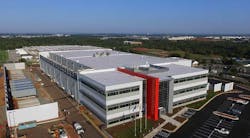This post from QTS is a special Data Center Frontier brief covering the top benefits of a hyperscale data center. The full report explores how the increasing need for resources from the business perspective has led to the development of powerful cloud data centers called hyperscale data centers.
Download the full report.
The growing importance of data analytics and cloud—the result of big data coming from ubiquitously networked end-user devices and IoE alike—has added to the value and growth of data centers. Furthermore, the increasing need around resources from the business perspective has led to the develop-ment of powerful cloud data centers called hyperscale data centers. This is why, according to Cisco, they will represent 47% of all installed data center servers by 2020. In other words, they will account for 83% of the public cloud server installed base in 2020 and 86% of public cloud workloads.
Today, hyperscale cloud operators are increasingly dominating the cloud landscape. But, it’s important to understand why and the business drivers behind this growth around hyperscale data center operators. Consider these five benefits and strategies when working with hyperscale data center environments.
1. Those resources—I needed them yesterday.
Very simply put, hyperscale organizations require speed to deliver. And, they want huge amounts of data capacity… now. At its core hyperscale is built on three components: speed to build, speed to deploy and speed to respond. Working with a hyperscale data center provider can help you deliver on all three. Hyperscale use-cases require a phased approach to execution. A good partner will help guide you through deployment and ensure that you have the right services and space to grow. Most of all, this level of planning greatly improves the time-to-value for the organization.
2. My data center can never fail.
According to a recent study from Ponemon Institute, the average cost of a data center outage has steadily increased from $505,502 in 2010 to $740,357 today (or a 38% net change). This means that the average cost of an outage by 2020 may cost an organization $1.1 million or more! Throughout their research, they found that maximum downtime costs increased 32% since 2013 and 81% since 2010; with the maximum downtime costs for 2016 topping at $2,409,991. Here’s the bottom line—if you’re a hyperscale organization, an outage will cost you quite a bit. This is why it’s more important than ever to work with a hyperscale partner that can keep your environment up and resilient. A good partner will have the proven experience delivering hyperscale deployments (some in excess of 100 megawatts) in existing and new properties. These types of partners will have deeper understanding and appreciation of what challenges hyperscale providers face because they will have overcome those very same obstacles themselves. This experience will range from a deep understanding of networking and fiber, to being a responsible consumer of energy and a sustainability.
[clickToTweet tweet=”In the hyperscale world—visibility can mean everything. ” quote=”In the hyperscale world—visibility can mean everything. “]
3. I absolutely need to know what’s going on in my data center, at all times.
Very simply, you can’t manage what you can’t see. And, in the hyperscale world—visibility can mean everything. The last thing you’d want is having too many people managing a hyperscale ecosystem full-time. This is usually a symptom of a bad management platform. A good hyperscale provider will be able to deliver upon a service-based integrated technology that delivers optics and controls that maximize performance through a single pane of glass. This means managing critical components around big data and cloud from a truly distributed computing perspective.
4. I need a contract that’s actually flexible!
You’re deploying a new hyperscale environment. And, you can’t always predict if it’ll take off like a firework and fizzle out; or if the platform will be there to stay and grow very dynamically. The point is that you need a hyperscale partner that will, very simply, work with you. Hyperscale organizations must look for good partners which are capable of scale and grow with them, as well as, be able to provide a flexible contract.
5. I’d like everything for free; or at least with better economics.
Yes, it would be nice to get everything for free, but what’s truly important is the understanding of the true cost of ownership (TCO). Beyond just asking “what’s this going to cost?” it’s important to work with a hyperscale partner which can help you align your business strategy with your hyperscale requirements. Remember, there is value beyond the cost per kilowatt, with an expanded digital footprint comes expanded security, management, maintenance and cooling implications. A good partner will be completely transparent and give you a very clear understanding round TCO, price, and billing.
More and more, like sophisticated warehouses that grow in scale quickly and dynamically, you’ll see resilience will be less about the building and more about the interconnection of multiple facilities. Traditional brick and mortar operations will get less sophisticated, but the software control systems will become the focus and will operate and much higher functional levels. Hyperscale data centers are built with scale in mind and the power to interconnect various points for a variety of emerging use-cases. With big data, business intelligence, and cloud computing all impacting how hyperscale organizations leverage their critical resources, hyperscale data center partners are there to make life easier and evolve key business strategies.
You can also download the complete brief, “Top 5 Benefits of a Hyperscale Data Center – a QTS Perspective,” courtesy of QTS.


